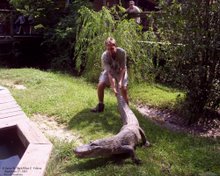
Wednesday turned out to be a great day out in Whiskey Bay. I lead a snake field trip for a LSU Native Wildlife class. Since we had been told this was going to be a snake trip for a herptetology class, I was surprised to see that many of the students were carrying binoculars. After our brief introduction at 3:15 p.m., we headed down Happytown Rd., where had had some luck in the past flipping cover. It was refreshing to see the mosquitos were represented in such healthy abundance. We flipped everything in site, and only turned up a few juvenile five-lined and a couple of adult broad-headed skinks. I suppose I should also mention the couple of nice purple ground beetles we found too.
As it would turn out, the day actually belonged to the birds. Just along the levee road (north of I-10), we had three mentionable experiences. I kept seeing a large raptor soaring on long, flat wings behind the tree line. After coming around a curve in the road, the bird was now in good viewing condition. It proved to be an adult Bald Eagle, being harassed by an Osprey. Most of the students were able to see it before it disappeared again behind the tree line. About 1/2 mile further down the road, I saw more birds soaring off to the left. Three Swallow-tailed Kites with three Turkey Vultures! One of the students asked "What kind of tailed kite is it?".
Riding with me in the USGS truck was a young lady from Zimbabwe, Africa. She had been asking me about turkeys in the Basin. We knew there was a turkey hunt going on, so I wasn't surprised when the topic came up. I told her that I had never seen turkeys in the Basin and that I probably hadn't seen a turkey in the wild in ten years or so. Before we could say anything else, a gobbler Wild Turkey ran acorss the road in front of us coming from the levee! I couldn't believe it!
So, even though we didn't see all that many herps, we had a great day out regardless. We did see a couple of banded watersnakes and a few of last year's alligators. We need some serious rain here in the Basin. There are places that are usually hosting standing water, that have been dry for months!
James









